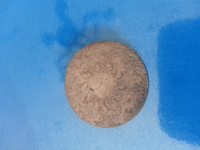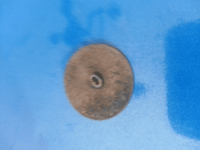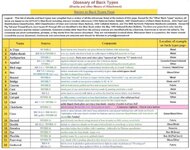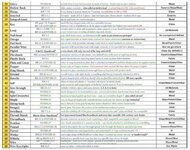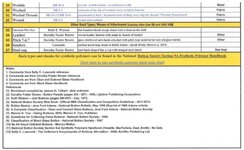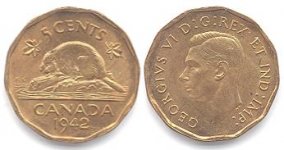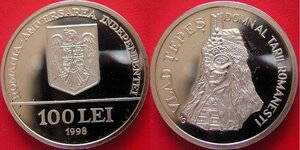Navigation
Install the app
How to install the app on iOS
Follow along with the video below to see how to install our site as a web app on your home screen.
Note: This feature may not be available in some browsers.
More options
You are using an out of date browser. It may not display this or other websites correctly.
You should upgrade or use an alternative browser.
You should upgrade or use an alternative browser.
old flat button. .
- Thread starter Vino
- Start date
FreeBirdTim
Silver Member
- Sep 24, 2013
- 3,851
- 6,938
- 🥇 Banner finds
- 1
- Detector(s) used
- Garrett AT Pro
- Primary Interest:
- All Treasure Hunting
Very nice find! Looks like a sunflower design, so definitely not military. Probably pre-1820, based on the shank and lack of stamping on the back. I'm no expert, but I've learned a lot since I started finding flat buttons myself.
Vino
Banned
- Jul 7, 2013
- 3,801
- 5,045
- Detector(s) used
- Ctx3030. Xp deus
- Primary Interest:
- All Treasure Hunting
- Thread starter
- #3
Very nice find! Looks like a sunflower design, so definitely not military. Probably pre-1820, based on the shank and lack of stamping on the back. I'm no expert, but I've learned a lot since I started finding flat buttons myself.
Thanks Tim..
Ninjafossils
Hero Member
- Dec 18, 2012
- 676
- 345
- Detector(s) used
- Garrett Ace 250
Tesoro Compadre
Garrett AT Pro
- Primary Interest:
- Other
NJ Garrett
Full Member
- Apr 7, 2013
- 115
- 235
- Primary Interest:
- All Treasure Hunting
I have found a few buttons that are similar to this. Folks on this site told me that they were "tombac" buttons, circa late 1700's. Hope this helps!
artyfacts
Bronze Member
- May 1, 2010
- 1,144
- 1,239
- 🥇 Banner finds
- 3
- Detector(s) used
- Whites DFX, MX7, Minelab Manticore
- Primary Interest:
- All Treasure Hunting
Nice decorative flaty. Looks to be mid 1750 or earlier. I dont believe its a Tombac. Tombac's are usually a white metal, and in most cases hold up better then there copper comrades depending on the soil. Here is a button back type list for future finds, sorry there are no pictures but its helpful. Just right click and save to where you want... Arty
Attachments
CRUSADER
Gold Member
Its a 1750-80s dandy button, maybe not the usual large one but you get small/medium ones as well. Civvy not military.
Vino
Banned
- Jul 7, 2013
- 3,801
- 5,045
- Detector(s) used
- Ctx3030. Xp deus
- Primary Interest:
- All Treasure Hunting
- Thread starter
- #9
Nice decorative flaty. Looks to be mid 1750 or earlier. I dont believe its a Tombac. Tombac's are usually a white metal, and in most cases hold up better then there copper comrades depending on the soil. Here is a button back type list for future finds, sorry there are no pictures but its helpful. Just right click and save to where you want... Arty
Thanks arty...that should help in the future also...
CRUSADER
Gold Member
Thanks arty...that should help in the future also...
Its not a tombac.
CRUSADER
Gold Member
I know that much...tombac are white right?
They almost look silver/grey when they come out the ground.
TheCannonballGuy
Gold Member
- Feb 24, 2006
- 6,596
- 13,390
- Detector(s) used
- White's 6000, Nautilus DMC-1, Minelab
- Primary Interest:
- Relic Hunting
Confusion can come from the fact that archeologists (who write the books) incorrectly call certain silvery-grey metal buttons simply Tombac buttons. In actuality, there are two basic types of Tombac: the color of one type is golden, the other is silvery-grey (or "white").
In Metallurgy dictionaries, the metal named Tombac is a form of brass, containing approximately 85% copper with 15% zinc. Simple Tombac's color is "golden" (distinctly more "orange" than yellow brass). The other version of Tombac, which we button-diggers are familiar with although most do not know its correct name, is called White-Tombac, because it is classified among what metallurgists call the "White Metals." White-Tombac differs from ordinary Tombac in that it contains a small percentage of Arsenic (which is a metal) along with the usual copper and zinc. Adding Arsenic to the molten copper-&-zinc alloy changes its color to silvery-grey. The Arsenic in the alloy may be the explanation for why White-Tombac buttons often come out of two centuries of burial with little or none of the patina-encrustation we typically see on dug buttons.
During World War Two, some Canada 5-cent coins were made of simple Tombac. Here is a photo to show you its color. The other photo (a 1998 Romania 100 Lei coin) shows what White-Tombac looks like when it is highly polished.
The confusion could be remedied if the late-1700s buttons were called White-Tombac buttons instead Tombac buttons. The DAACS document's section on "Button Metal Color," it says (but doesn't "do" in the charts there)... "Tombac buttons should be [classified as] white, unless there is evidence of gilding (goldplating)." See section 1.15 in the DAACS document. http://www.daacs.org/wp-content/uploads/buttons.pdf
In Metallurgy dictionaries, the metal named Tombac is a form of brass, containing approximately 85% copper with 15% zinc. Simple Tombac's color is "golden" (distinctly more "orange" than yellow brass). The other version of Tombac, which we button-diggers are familiar with although most do not know its correct name, is called White-Tombac, because it is classified among what metallurgists call the "White Metals." White-Tombac differs from ordinary Tombac in that it contains a small percentage of Arsenic (which is a metal) along with the usual copper and zinc. Adding Arsenic to the molten copper-&-zinc alloy changes its color to silvery-grey. The Arsenic in the alloy may be the explanation for why White-Tombac buttons often come out of two centuries of burial with little or none of the patina-encrustation we typically see on dug buttons.
During World War Two, some Canada 5-cent coins were made of simple Tombac. Here is a photo to show you its color. The other photo (a 1998 Romania 100 Lei coin) shows what White-Tombac looks like when it is highly polished.
The confusion could be remedied if the late-1700s buttons were called White-Tombac buttons instead Tombac buttons. The DAACS document's section on "Button Metal Color," it says (but doesn't "do" in the charts there)... "Tombac buttons should be [classified as] white, unless there is evidence of gilding (goldplating)." See section 1.15 in the DAACS document. http://www.daacs.org/wp-content/uploads/buttons.pdf
Attachments
Last edited:
Vino
Banned
- Jul 7, 2013
- 3,801
- 5,045
- Detector(s) used
- Ctx3030. Xp deus
- Primary Interest:
- All Treasure Hunting
- Thread starter
- #15
Confusion can come from the fact that archeologists (who write the books) incorrectly call certain silvery-grey metal buttons simply Tombac buttons. In actuality, there are two basic types of Tombac: the color of one type is golden, the other is silvery-grey (or "white").
In Metallurgy dictionaries, the metal named Tombac is a form of brass, containing approximately 85% copper with 15% zinc. Simple Tombac's color is "golden" (distinctly more "orange" than yellow brass). The other version of Tombac, which we button-diggers are familiar with although most do not know its correct name, is called White-Tombac, because it is classified among what metallurgists call the "White Metals." White-Tombac differs from ordinary Tombac in that it contains a small percentage of Arsenic (which is a metal) along with the usual copper and zinc. Adding Arsenic to the molten copper-&-zinc alloy changes its color to silvery-grey. The Arsenic in the alloy may be the explanation for why White-Tombac buttons often come out of two centuries of burial with little or none of the patina-encrustation we typically see on dug buttons.
During World War Two, some Canada 5-cent coins were made of simple Tombac. Here is a photo to show you its color. The other photo (a 1998 Romania 100 Lei coin) shows what White-Tombac looks like when it is highly polished.
The confusion could be remedied if the late-1700s buttons were called White-Tombac buttons instead Tombac buttons. The DAACS document's section on "Button Metal Color," it says (but doesn't "do" in the charts there)... "Tombac buttons should be [classified as] white, unless there is evidence of gilding (goldplating)." See section 1.15 in the DAACS document. http://www.daacs.org/wp-content/uploads/buttons.pdf
Wow!!! Thanks for all that great info. .
artyfacts
Bronze Member
- May 1, 2010
- 1,144
- 1,239
- 🥇 Banner finds
- 3
- Detector(s) used
- Whites DFX, MX7, Minelab Manticore
- Primary Interest:
- All Treasure Hunting
Here is a site from the UK on when backmarks started. It is a good tool for judging if your flaty is early or late 18th century.
Button Makers and their backmarks - ukdfd
Button Makers and their backmarks - ukdfd
Top Member Reactions
-
 3338
3338 -
 1972
1972 -
 1931
1931 -
 1176
1176 -
 1097
1097 -
 894
894 -
 808
808 -
 803
803 -
 794
794 -
 792
792 -
 768
768 -
 532
532 -
 491
491 -
 460
460 -
 443
443 -
 430
430 -
 424
424 -
 420
420 -
E
415
-
 380
380
Users who are viewing this thread
Total: 2 (members: 0, guests: 2)


